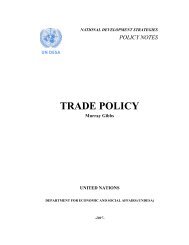SCP in Agriculture and Rural Development
SCP in Agriculture and Rural Development
SCP in Agriculture and Rural Development
You also want an ePaper? Increase the reach of your titles
YUMPU automatically turns print PDFs into web optimized ePapers that Google loves.
Promot<strong>in</strong>g the protection of ecosystem services, <strong>in</strong>clud<strong>in</strong>g carbon mitigation, biodiversity,<br />
<strong>and</strong> l<strong>and</strong>scape<br />
A comb<strong>in</strong>ation of regulations, charges <strong>and</strong> environmental taxes, <strong>in</strong>centive payments, st<strong>and</strong>ards,<br />
awareness-rais<strong>in</strong>g, research, <strong>and</strong> <strong>in</strong>stitution <strong>and</strong> capacity build<strong>in</strong>g have been deployed to promote<br />
the protection of the natural resource base while improv<strong>in</strong>g the liv<strong>in</strong>g conditions of those liv<strong>in</strong>g <strong>in</strong><br />
rural areas. At the same time, agricultural support <strong>in</strong>struments, particularly subsidies <strong>in</strong> developed<br />
countries, cont<strong>in</strong>ue to encourage <strong>in</strong>tensive <strong>and</strong> unsusta<strong>in</strong>able agricultural practices. Hence, while<br />
below we focus on different policy <strong>in</strong>struments used to promote the protection of ecosystem<br />
services, the need for policy reform lead<strong>in</strong>g to the removal of perverse subsidies must be part of<br />
any discussion <strong>in</strong> this context.<br />
Taxes <strong>and</strong> charges to <strong>in</strong>tegrate directly the environmental costs of agricultural activities <strong>in</strong>to<br />
farmers’ production decisions have been less used <strong>in</strong> agriculture than <strong>in</strong> other sectors, reflect<strong>in</strong>g<br />
logistical difficulties <strong>and</strong> poorly def<strong>in</strong>ed property rights. Direct payments for ecosystem services are<br />
more common, with some governments around the world pay<strong>in</strong>g rural l<strong>and</strong>owners to steward their<br />
l<strong>and</strong> <strong>in</strong> ways that will generate ecosystem services while at the same time promot<strong>in</strong>g rural<br />
development. The Conservation Reserve Program <strong>in</strong> the United States, for <strong>in</strong>stance, compensates<br />
farmers <strong>in</strong> exchange for their protection of endangered wildlife habitat, open space <strong>and</strong>/or<br />
wetl<strong>and</strong>s. Colombia, Ecuador, Mexico <strong>and</strong> South Africa target their payments toward stewards of<br />
watershed services. Other examples <strong>in</strong>clude payments for protection of a wide range of ecosystem<br />
services (biodiversity, watersheds, carbon sequestration) <strong>in</strong> Costa Rica, payments for<br />
preserv<strong>in</strong>g semi-natural pastures <strong>in</strong> Sweden, <strong>and</strong> ecological payments for extensive meadows <strong>and</strong><br />
animal welfare <strong>in</strong> Switzerl<strong>and</strong>. 14 15<br />
In some rural areas <strong>in</strong> develop<strong>in</strong>g countries, households lack most types of assets <strong>and</strong> hold very<br />
small plots of l<strong>and</strong> while operat<strong>in</strong>g <strong>in</strong> remote, <strong>in</strong>hospitable environments. Innovative approaches to<br />
reduce poverty <strong>in</strong> such environments require l<strong>in</strong>k<strong>in</strong>g isolated communities with distant markets <strong>and</strong><br />
communities, <strong>and</strong> <strong>in</strong>clude tapp<strong>in</strong>g <strong>in</strong>to markets for ecosystem services, which the poor may be<br />
supply<strong>in</strong>g <strong>in</strong> large amounts. Another option is tapp<strong>in</strong>g <strong>in</strong>to specialty markets for identity-based<br />
goods <strong>and</strong> services, <strong>in</strong>clud<strong>in</strong>g susta<strong>in</strong>able tourism, <strong>and</strong> <strong>in</strong> particular ethnic/ecological tourism <strong>and</strong><br />
fair trade. 16<br />
Information <strong>and</strong> communication technologies can be important tools <strong>in</strong> realis<strong>in</strong>g these<br />
opportunities. High transaction costs are the s<strong>in</strong>gle largest barrier to l<strong>in</strong>k<strong>in</strong>g these remote, but<br />
culturally <strong>and</strong>/or biodiversity rich rural areas with the global community, <strong>and</strong> <strong>in</strong>clude costs that<br />
range from f<strong>in</strong>d<strong>in</strong>g <strong>in</strong>formation about the market (Who <strong>and</strong> where are the potential buyers? What<br />
st<strong>and</strong>ards must be complied with?), to gett<strong>in</strong>g <strong>in</strong> touch with potential customers <strong>and</strong> negotiat<strong>in</strong>g<br />
14 OECD (2004), <strong>Agriculture</strong> <strong>and</strong> the environment: lessons learned from a decade of OECD work.<br />
15 http://ecosystemmarketplace.com/pages/static/about.conservation_backgrounder.php.<br />
16 Berdegué, J.A. (2005), “Pro-poor <strong>in</strong>novation systems”, Background paper prepared for IFAD, December.<br />
5 of 9
















